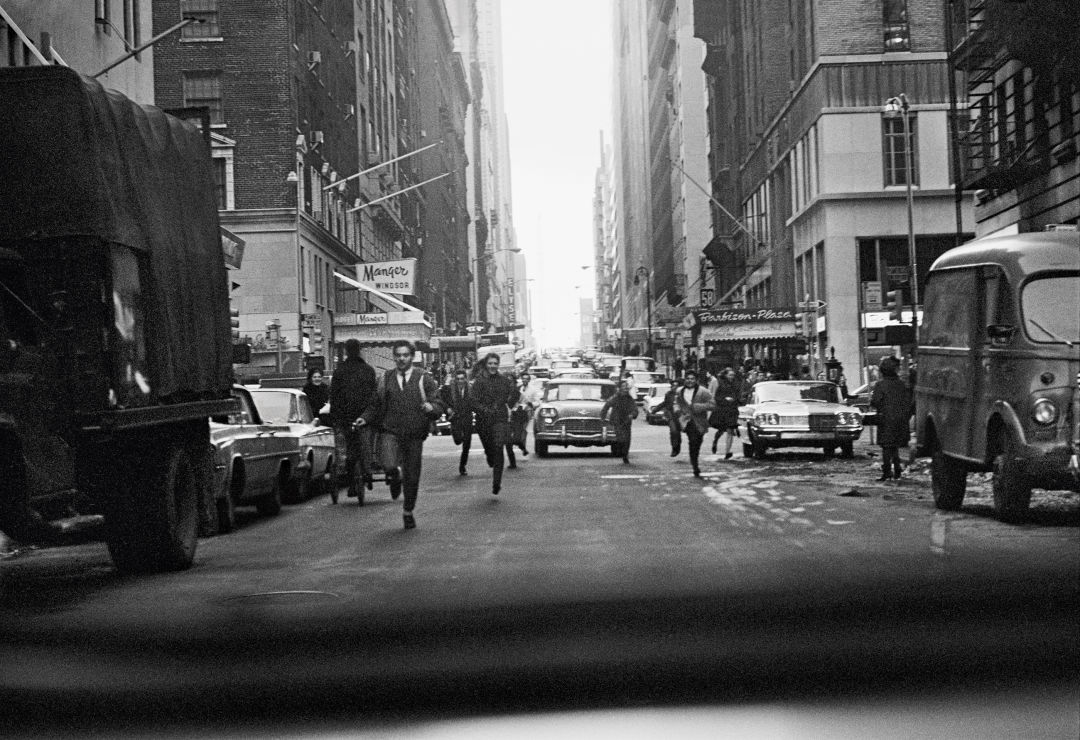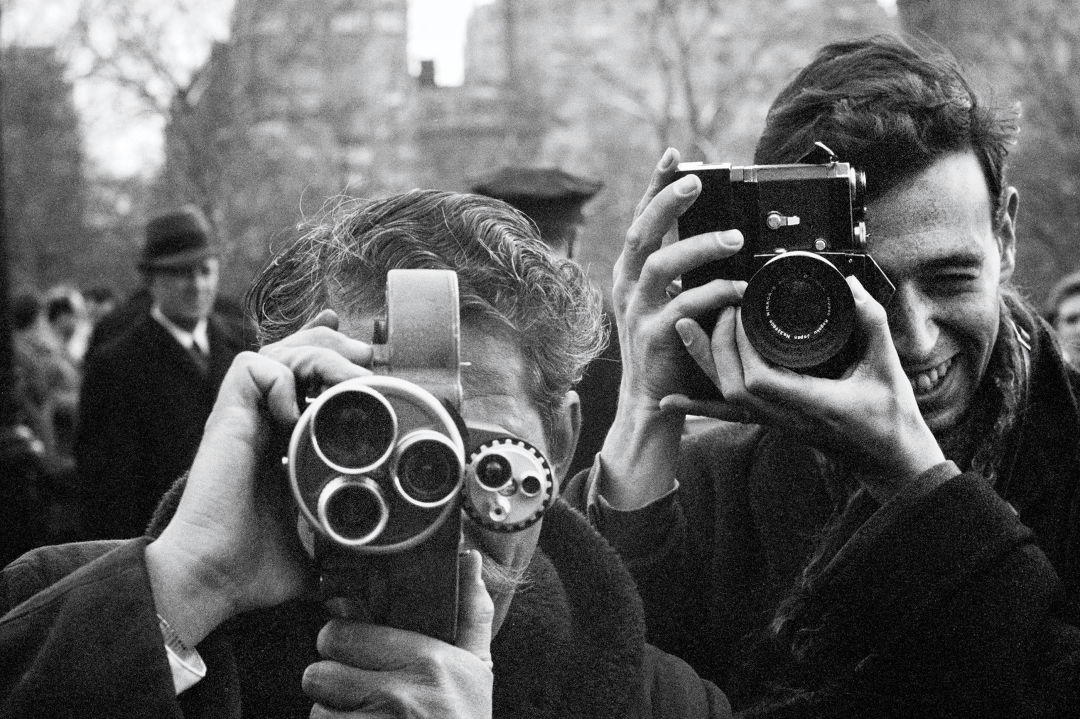A Picture of Fame: Paul McCartney’s Beatlemania Photos at PAM

In February 1964, the Beatles landed at Kennedy airport, newly renamed for the recently assassinated president. LBJ had just settled into the oval office and was pushing hard toward reelection and to pass the Civil Rights Act. It was the band’s first trip to the US, and the Beatles expected to find something in line with post–WWII narratives: give us “your tired, your poor, your huddled masses.” Instead they found a deeply segregated place and a shocking number of guns. Previously, pop stars were pop stars and politics were politics. But the Beatles were quickly becoming the most famous, and therefore influential, people the world had ever seen. Everyone wanted to know what they thought—about everything.
“What do you think of President Johnson?” reporters asked. “Never met him,” the band joked.
“I want to ask the Beatles what they think of Barry Goldwater,” said another. “I don’t like him,” McCartney said of the Republican presidential nominee.
Modern, globalized celebrity took shape around the Beatles in this moment—Beatlemania. It was the first time the world had seen the potential for celebrity itself to sway public opinion, long before political endorsements from the Taylor Swifts of the world meant something, before tweets turned campaigns Brat green.

There are no doubt millions of photos recording those first few months of 1964, the “British Invasion.” But Paul McCartney was snapping his own, too. They were simple, social shots, soon forgotten in a drawer, until recently, when hundreds of these images were recovered and mounted in London’s National Portrait Gallery. Now touring internationally, Eyes of the Storm, at the Portland Art Museum through January 19, isn’t so much a photography exhibit as it is a picture taken from the point of view of fame itself—the inside looking out at all of us.
Some images are interesting on their own, but far more compelling is the access they provide. Tender shots of John Lennon in the back of a limousine. Ringo Starr crumpling his worried face as the band’s private Pan Am flight descends into New York City. This was the moment the Beatles became the Beatles, when a newly globalized media apparatus created them, while they were busy creating themselves.

In a gorgeous essay introducing the book that goes with the show, Jill Lepore outlines the problems caused by equating celebrity with expertise. The Beatles, Lepore writes, were asked, “preposterously, to explain their own significance, or the forces behind the generational change, cultural revolutions and political transformations in which they were caught up.” A Harvard history professor and New Yorker writer herself, she all but says, “that’s my job.”
In the book, McCartney admits he’s not a great photographer, instead saying he “happened to be in the right place at the right time.” However, it is easy to confuse his casual shots with an artistic style popularized by documentary and street photographers in the 1960s, an avant garde called the “snapshot aesthetic” championed by John Szarkowski at the Museum of Modern Art: spontaneous, clumsy, candid, observational, personal. McCartney’s framing is often awkward and he almost always misses focus. Many of the photos here are also pulled from contact sheets, because the original negatives were lost, which further lowers their resolution—that’s also why several are overlaid with grease pencil Xs.

Whatever their aesthetic merits, these technical foibles don’t diminish the images’ historical value. McCartney’s photos show an outsider’s view of 1960s America, fascinated but haunted, and eventually disenchanted. A sea of devout fans is the backdrop or subject of many, hinting at the confusing downside of fame on this scale. Along with the fans, McCartney took lots of pictures of blue-collar workers, usually from car or airplane windows: airport workers, nurses, the police escorts that followed them everywhere they went. Their guns in particular fascinated him, and he accidentally fetishized them in his photos. One, a close-cropped shot of a motorcycle cop’s pistol loaded with chrome highlights and lots of leather, would fit in a Tom of Finland drawing.

The police, the cars, the planes, all these layers between McCartney and the real world function as a reminder that celebrity is manufactured, fake, that you can’t touch it. In several captions, he mentions wondering about the lives of the rail workers, airline luggage men, and officers. The inward-facing photos, the ones of the rest of “the boys” and their famous friends, give some indication of a different set of untold stories.
In these we're a fly on the wall of the Beatles’ social life, hanging out with Ronnie Spector, in the studio with the band and producer sir George Martin, the “fifth Beatle.” In this early phase, their haircuts and matching outfits feel like an act. Despite how famous they’ve since grown individually, it’s at times hard to tell them apart. Famously, reporters couldn’t either, instead shouting, “Hey Beatle.” Except Ringo, of course. He stands out.

Ringo wearing yesterday’s shave, a yellow polyester shirt, giant shades, and horribly chapped lips. Ringo in a mariner’s cap, cigarette burning lazily in his hand, lots of rings, his face puckered. Ringo is confused in every photo. He’s never quite posing. And it seems he wouldn’t know how if he tried. With Central Park behind them on their first day in America, Paul, John, and Ringo stand for a crowd of reporters. John already has his regal heavy eyelids, looking exactly the part of a rock star. Paul (the best pictures are the ones someone else took with Paul’s camera) is looking across at Ringo, on the verge of laughing. Ringo’s bangs cut into his eyes, his mouth is crooked, and he’s almost pouting as he tries to grin. He’s a kid who hasn’t figured out how to smile, much less perform the band’s practiced cool, and Paul is his (younger) older brother telling him to smarten up. They’re trying their best to be this thing that is the Beatles, to embody their global fame.
While there is a literal soft focus to the majority of these photos, their sentiment rings crisp. There’s nothing scandalous or untoward in the show. But the pictures are revealing, as much a cultural study as an intimate look at these four characters with whom much of the world has been on a first-name basis since 1964. Why them, what accounted for this unprecedented spectacle, this cultural and awkwardly political power? What about their songs or looks set off this mania? Understanding why the world adored John, Paul, George, and Ringo wasn’t so much about analyzing the Beatles’ appeal. A lot of it had nothing to do with them. To twist McCartney’s words just slightly: right time, right place.





